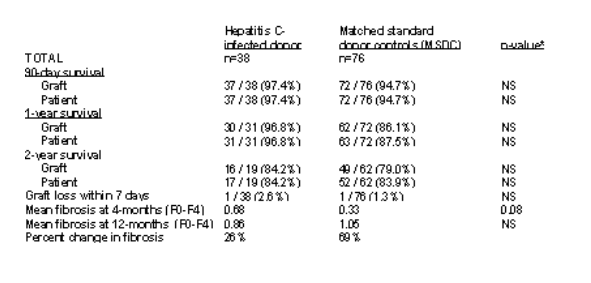 |
 |
 |
| |
HCV-Infected Liver Donors for Liver Transplantation Are Recommended Instead of Uninfected HCV-Donated Livers, from a new study presented at DDW 2007
|
| |
| |
Reported by Jules Levin
DDW, May 19-24, 2007, Washington DC
Dr. Kwo, the study author, said that he felt confident in recommending that HCV-infected donors be "considered as first line therapy to increase the available donor pool of organs for HCV patients needing liver transplants.... preliminary results suggest that HCV-infected liver transplant recipients receiving livers from HCV-infected donors may have a slower rate of fibrosis progression at 1-year. A trend was seen in survival advantage for those receiving HCV-donor grafts compared to standard donor controls".
Commenting on the study, John M. Vierling, M.D., immediate past president of the American Association for the Study of Liver Diseases, noted that the waiting list for liver transplants has grown from 7,200 patients in 1999 to more than 18,000 patients today.
"The majority of that increase has been driven by HCV-infected patients with cirrhosis or hepatocellular carcinoma who need new livers," said Dr. Vierling, who is a professor of medicine and surgery at Baylor College of Medicine in Houston.
In response to that demand, he said, the United Network for Organ Sharing, the quasi-governmental agency that maintains the waiting lists for organ donations and oversees donor organ distribution, eased criteria for donors to include organs harvested from cadavers, from older donors, or-in the case of liver transplants-the use of livers from HCV-infected donors into HCV-infected recipients.
"There was no difference in survival at any of the time points," Dr. Kwo said.
He noted that one possible explanation for the trend toward improved survival with livers from infected donors was the natural history of the donor liver.
Simply stated, he said, the liver from an infected donor was accustomed to survival in the presence of HCV infection, so when the liver encountered HCV in the host it was a familiar milieu.
By contrast, a liver from an uninfected donor may be particularly vulnerable when it encounters HCV, especially when the encounter occurs in the presence of immune suppression, as is the case with organ transplant patients.
Use of hepatitis C-infected donors in liver transplantation: a case-control study
P. Kwo1; S. Wilson1; R. S. Mangus2; A. Tector2; J. A. Fridell2; R. Vianna2; S. Liangpunsakul1; V. Misra1; S. Bhardwaj1
1. Medicine, Indiana Universtiy School of Medicine, Indianapolis, IN, USA.
2. Surgery, Indiana University School of Medicine, Indianapolis, IN, USA.
Background
To meet the increasing demand for cadaveric donor livers, some centers transplant livers from hepatitis C (HCV)-infected donors into recipients with HCV-related cirrhosis. This study utilizes a case-control design to compare transplant outcomes for 38 recipients of livers from HCV-infected donors to those for 76 standard, non-extended criteria (ECD) donors (1 case / 2 controls).
Methods
Data was extracted from the transplant center registry, UNOS data, and from the original on-site donor data chart. Thirty percent of all donors met non-ECD criteria (standard donors) and were included as potential matches for the case-control study. Each HCV-positive liver donor recipient was matched to two standard donor recipients as matched standard donor controls (MSDC) by: recipient age +/- 10 years, primary diagnosis, cancer stage for those with HCC, recipient MELD +/- 5, and donor age +/- 10 years. Outcomes included graft and patient survival at 3-months, 1-year and 2-years; perioperative death; and, HCV recurrence by 4-month and 1-year fibrosis (F0-F4).
Results
The HCV-donor and MSDC groups did not differ for recipient or donor demographics or in cold and warm ischemia time. Survival results and fibrosis progression are shown in the table. Median follow- up time was 36 months. Kaplan-Meier actuarial survival demonstrated improved graft survival for HCV-infected donors with a trend toward significance (p=0.10).
Conclusions
These preliminary results suggest that HCV-infected liver transplant recipients receiving livers from HCV-infected donors may have a slower rate of fibrosis progression at 1-year. A trend was seen in survival advantage for those receiving HCV-donor grafts compared to standard donor controls. The use of HCV positive donors may be considered as a first line therapy to increase the available donor pool of organs in those undergoing OLT for HCV-related cirrhosis.
Survival Analysis for Hepatitis C Infected Liver Transplant recipients for Donors Previously Infected with Hepatitis C (n=38) or Matched Standard Donor Controls (n=76)
One year graft survival rate was 96.8% for patients receiving the HCV-infected donor liver vs 86.1% using the standard uninfected donor liver. Two-year graft survival was 84.2% for the infected liver vs 79% for the uninfected liver. These differences were not statistically significant. The mean increase in fibrosis was 26% in the HCV-infected donor group vs 69% in the uninfected donor group, and this may be considered a surrogate for HCV recurrence.

|
| |
|
 |
 |
|
|